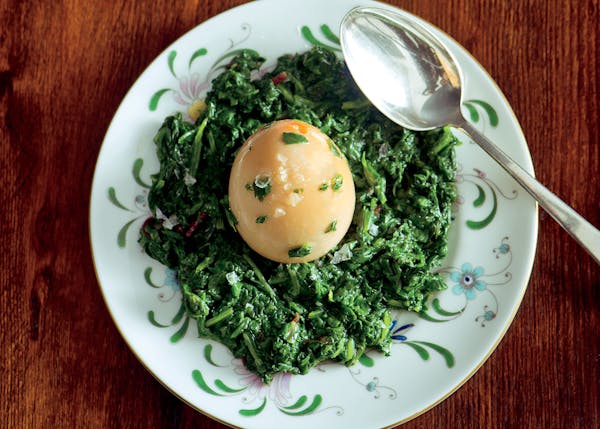By looking back thousands of years to trace global influences on Jewish cuisine, venerable cookbook author Joan Nathan discovered a lesson for today. She found that what we think of as Jewish food, from the matzo ball to the bagel, tells a larger story of expulsions, wanderings and explorations across borders. In other words, immigration.
Her new volume, "King Solomon's Table" (Knopf, 382 pages, $35), traces the path of Jewish migration throughout the world since biblical times. As Jews moved through the diaspora, whether as merchants or as refugees, they brought with them ingredients and techniques that got baked into ever-evolving world cuisines, and transformed their own pantries with Indian spices, Italian produce, Sumerian beans and New Mexican chiles.
Human migration has had a profound influence on food over eons. And yet, as the United States and other countries move to limit immigration and acceptance of refugees, every cuisine stands to lose a bit of flavor, Nathan said.
"We're going to have a dark age of cuisine if we don't have any more immigrants," said Nathan, a two-time James Beard Award winner, whose 1994 book "Jewish Cooking in America" was recently named a culinary classic by the International Association of Culinary Professionals.
Her latest book hits stores April 4 — just in time for Passover, a holiday that commemorates a particularly important migration for the Jewish people: their exodus from ancient Egypt and 40-year wander through the desert.
With recipes for curries, cookies and five kinds of haroset — the fruit paste on the Passover Seder plate that symbolizes the mortar Jewish slaves mixed in ancient Egypt — Nathan tells a story that's weightier than her recipes' measurements.
We spoke to Nathan about trends in Jewish cuisine, the perfect global Passover meal, and what stands to be lost when borders close.
Q: Tell us about "King Solomon's Table" and why you wrote it.
A: I've written a lot about Jewish food and different places, and the story, in a way, got more complicated as I went along. In a sense, it's the same story that I've spent my life writing, but I guess the older you get, the more you know. I started learning so many things that really changed the way I looked at Jewish food, and I decided to put them all together. It told a different story from the one I always thought I knew.
As I started testing certain recipes, say, a chickpea pancake, I realized how very, very old they were. As King Solomon said, there's nothing new under the sun, and there really isn't. We're going back to pomegranate paste and date honey and all kinds of ingredients from the ancient world that have been around forever. Learning the story about a recipe teaches you so much about the past, and about food.
Q: You mention in the book some ingredients that are in vogue now but date back hundreds or even thousands of years, such as almond milk, which the Medieval French rabbi Rashi drank.
A: He did that because almond milk was an ancient drink and also something you could use with meat [because of Jewish dietary restrictions on mixing meat and dairy]. Look at chickpeas. In the Epic of Gilgamesh, they mention chickpea flour, and that was maybe 3000 BCE. In Jordan, they found chickpeas from 12,000 years ago. Sesame seeds were used in 1700 BCE and sesame oil was the earliest processed oil not made of animal. So, my guess is, hummus had been around for a long time.
Q: What are some distinctly Jewish foods that people don't realize come from other cultures?
A: People don't know about bagels. They really originated in ancient Egypt. They went around a lot of Syria and Iraq, and they were like rolls with a hole. In different countries they were made differently. Then they were boiled and baked. And then they came to Poland, and Jewish bakers brought them to the U.S.
Q: Is there something inherently Jewish that connects the dishes that come from so many different regions?
A: There are three aspects. One is the dietary laws. Even if they are way in the back of your mind, they're still very important. Plus the religion and holidays are really what ties Jewish people together.
The second is the fact that Jews were always merchants, always looking for the new, whether it was going to India at the time of King Solomon, looking for spices and jewels to adorn the temple, or today when there are so many people in the food business.
The third is that Jews were kicked out of so many countries, so they had to adapt to new countries with new regionalisms, which meant that food had to be made with the dietary laws in mind, but also with what was available. That's why at Passover I always think the haroset is such an important part of the Seder, and I always have five different kinds from around the world, because it shows where the food is from.
Q: There are Jewish cookbooks that are Paleo, vegan, gluten-free. What are the latest trends in Jewish cooking that you are seeing?
A: I think it's all about getting back to the origins of food in general. In the food world, we are just exploring everything. It's not just with Jewish food, but with processed food — we are trying to get away from that and find the origins.
Q: Your book shows how important migration is to food. When migration is stopped, what is lost?
A: As far as I'm concerned, this story is so important right now. For example, I don't even think French cuisine would be anything without immigrants. What we think of as this perfect regional cuisine is of a country that has had immigrants forever and was considered the new promised land in the 19th century, and that's when it really got developed. The Poles came in, and the brioche was developed by a baker from Poland.
The U.S. was built on immigration, and since 1965 when the immigration laws changed and brought in new immigrants from a lot of Asian and South American countries, I think Jews and others have felt that they were very happy with what they were learning. Fortunately, America's taste buds have opened, and half the chefs that we have in the U.S. are cooking immigrant food and also using immigrant food for ideas.
Q: What would be a perfect global Passover menu from "King Solomon's Table"?
A: I would start with the Seder plate — you'd have haroset from Ferrara, and different ones from all over the world. This egg that I love, with spinach and onion, from Corfu. Delicious. Instead of gefilte fish, you could maybe go with aharaimi, a spicy Libyan fish, or an Indian fish curry. Then you have a chicken soup with matzo balls. You could have a brisket, or a fessenjan [walnut and pomegranate chicken stew] from Persia, provided you eat rice for Passover. Then you'd have carciofi alla Giudia, the most delicious artichokes, Jewish style, from Italy. For dessert, I would have a cardamom cake, and I'd probably have macaroons from Iraq. The story of migration is part of Passover.
Sharyn Jackson • 612-673-4853
Music Review: Anitta welcomes listeners into her 'Funk Generation' on new album
Ask Amy: Give up on estranged brother



